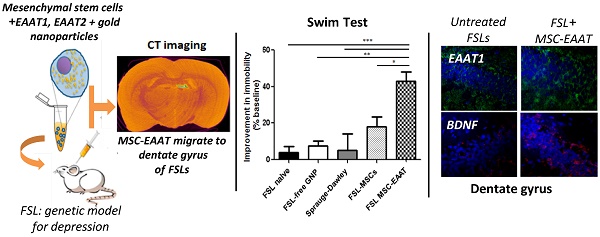当前位置:
X-MOL 学术
›
Theranostics
›
论文详情
Our official English website, www.x-mol.net, welcomes your
feedback! (Note: you will need to create a separate account there.)
Microvesicles as Potential Biomarkers for the Identification of Senescence in Human Mesenchymal Stem Cells
Theranostics ( IF 12.4 ) Pub Date : 2017-07-06 , DOI: 10.7150/thno.18915 Qian Lei , Teng Liu , Fei Gao , Hui Xie , Li Sun , Aiqi Zhao , Wenxiang Ren , Hao Guo , Liming Zhang , Hongxiang Wang , Zhichao Chen , An-Yuan Guo , Qiubai Li
Theranostics ( IF 12.4 ) Pub Date : 2017-07-06 , DOI: 10.7150/thno.18915 Qian Lei , Teng Liu , Fei Gao , Hui Xie , Li Sun , Aiqi Zhao , Wenxiang Ren , Hao Guo , Liming Zhang , Hongxiang Wang , Zhichao Chen , An-Yuan Guo , Qiubai Li

|
Senescence in human mesenchymal stem cells (MSCs) not only contributes to organism aging and the development of a variety of diseases but also severely impairs their therapeutic properties as a promising cell therapy. Studies searching for efficient biomarkers that represent cellular senescence have attracted much attention; however, no single marker currently provides an accurate cell-free representation of cellular senescence. Here, we studied characteristics of MSC-derived microvesicles (MSC-MVs) that may reflect the senescence in their parental MSCs. We found that senescent late passage (LP) MSCs secreted higher levels of MSC-MVs with smaller size than did early passage (EP) MSCs, and the level of CD105+ MSC-MVs decreased with senescence in the parental MSCs. Also, a substantially weaker ability to promote osteogenesis in MSCs was observed in LP than EP MSC-MVs. Comparative analysis of RNA sequencing showed the same trend of decreasing number of highly-expressed miRNAs with increasing number of passages in both MSCs and MSC-MVs. Most of the highly-expressed genes in LP MSCs and the corresponding MSC-MVs were involved in the regulation of senescence-related diseases, such as Alzheimer's disease. Furthermore, based on the miRNA profiling, transcription factors (TF) and genes regulatory networks of MSC senescence, and the datasets from GEO database, we confirmed that expression of miR-146a-5p in MSC-MVs resembled the senescent state of their parental MSCs. Our findings provide evidence that MSC-MVs are a key factor in the senescence-associated secretory phenotype of MSCs and demonstrate that their integrated characteristics can dynamically reflect the senescence state of MSCs representing a potential biomarker for monitoring MSC senescence.
中文翻译:

微囊泡作为潜在的生物标志物,用于鉴定人间充质干细胞的衰老
人间充质干细胞(MSCs)的衰老不仅导致机体衰老和各种疾病的发展,而且严重损害了它们作为有前途的细胞疗法的治疗性能。寻找代表细胞衰老的有效生物标志物的研究引起了广泛关注。然而,目前尚无单一标记物能提供细胞衰老的准确无细胞代表。在这里,我们研究了MSC衍生的微泡(MSC-MVs)的特征,这些特征可能反映了其亲本MSC的衰老。我们发现,衰老的晚期传代(LP)MSC分泌的MSC-MVs水平更高,而早期传代(EP)MSC的大小更小,而CD105 + MSC-MVs的水平随着衰老而在亲代MSCs中降低。还,在LP中观察到,与EP MSC-MV相比,在MSC中促进成骨的能力明显较弱。RNA测序的比较分析显示出相同的趋势,即随着MSC和MSC-MV中传代次数的增加,高度表达的miRNA的数目减少。LP MSC和相应的MSC-MV中的大多数高表达基因都参与了与衰老相关的疾病(例如阿尔茨海默氏病)的调控。此外,基于MSC衰老的miRNA分析,转录因子(TF)和基因调控网络,以及来自GEO数据库的数据,我们证实了MSC-MV中miR-146a-5p的表达与其亲代MSC的衰老状态相似。 。
更新日期:2017-10-01
中文翻译:

微囊泡作为潜在的生物标志物,用于鉴定人间充质干细胞的衰老
人间充质干细胞(MSCs)的衰老不仅导致机体衰老和各种疾病的发展,而且严重损害了它们作为有前途的细胞疗法的治疗性能。寻找代表细胞衰老的有效生物标志物的研究引起了广泛关注。然而,目前尚无单一标记物能提供细胞衰老的准确无细胞代表。在这里,我们研究了MSC衍生的微泡(MSC-MVs)的特征,这些特征可能反映了其亲本MSC的衰老。我们发现,衰老的晚期传代(LP)MSC分泌的MSC-MVs水平更高,而早期传代(EP)MSC的大小更小,而CD105 + MSC-MVs的水平随着衰老而在亲代MSCs中降低。还,在LP中观察到,与EP MSC-MV相比,在MSC中促进成骨的能力明显较弱。RNA测序的比较分析显示出相同的趋势,即随着MSC和MSC-MV中传代次数的增加,高度表达的miRNA的数目减少。LP MSC和相应的MSC-MV中的大多数高表达基因都参与了与衰老相关的疾病(例如阿尔茨海默氏病)的调控。此外,基于MSC衰老的miRNA分析,转录因子(TF)和基因调控网络,以及来自GEO数据库的数据,我们证实了MSC-MV中miR-146a-5p的表达与其亲代MSC的衰老状态相似。 。











































 京公网安备 11010802027423号
京公网安备 11010802027423号